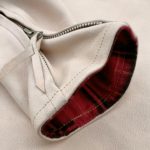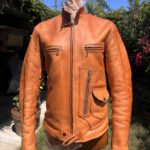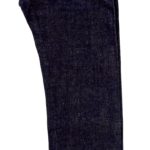
 Aaaaai… 





















 My MF® Bronco Champ Type II today (August 2023), natural veg-tan cowhide, with sunshine exposure, conditioning and some miles. 
MF® BRONCO CHAMP Type II, veg-tan cowhide, natural & black tea-core edition.
mfsc FW2022 HOOPER Collection
Made in USA
Mister Freedom® OGs may remember our first 1960s cafe racer style leather jacket, the MF® Bronco Champ Type I.
A heavy hitter in the “Speed-Safe Clothing for Modern Riders” line-up, the Type I was produced in Japan in 2009, and released in several horsehide options and color combinations.
Sonny Hooper called and said he’d like to see a comeback of that bad boy for a new stunt, so we listened.
We decided to have the Bronco Champ Type II made in the USA this time around, at the same small factory that has been producing our Mister Freedom® leather classics since 2013. That team of expert craftsmen is responsible for the MF® Campus, Ranch Blouse “Ringo”, “Randall” and “Bison”, the “Baloo”, and the “Lawrence”. They know what they’re doing.
The original design of the MF® Bronco Champ was inspired by 1940s~1970s motorcycle jacket styles (vintage Block-Bilt, Buco, Bates etc…), when leather was the best thing available to protect riders from spills, should one forget the old “Keep the rubber side down” biker’s adage.
The body pattern/fit was adapted from a vintage 1950s “Taubers of California” single rider’s jacket from my closet, a cut also referred to as cafe racer (as opposed to the “Brando style” double rider’s jacket.) Early advertising sometimes promoted those as “leather shirts” or “competition shirts”.
Another source of inspiration for the original MF® Bronco Champ was a 1960s racing jacket from the “ABC Leather” maker, a snazzy cream and red little number with stars on the sleeves I used to wear around, which also made an appearance in Japanese fashion magazine “Free & Easy” (the original “Dad’s Style” reference for round eyes) in 2005, back when I thought inhaling smoke was a good idea.
-

-
Vintage 1950s-60s Taubers of California single rider’s jacket, inspiration for the MF® Bronco Champ
-

-
ABC Leather and smoking dumb dumb, Free & Easy magazine, 2005
At the drafting table, I decided at the time to do the unthinkable, and mess with the timeless minimalist front panel design of single rider’s jackets by adding a D-pocket! Heresy.
It is commonly accepted that D-pockets have their design/purpose origin in early aviator clothing (1920s-30s), and made their way to double rider’s motorcycle jackets sometimes in the 1940s, as clothing companies probably figured there will always be less flyers than bikers as potential customers.
D-pockets are not found on classic single rider’s jacket, usually designed with one or two small chest zip pockets. Intended as glove-fitting racing “shirts”, a chest pocket the size of a pack of smokes was all one needed on the racetrack.
I remember sewing together a prototype D-pocket, and positioning it on my 50s Taubers to find the sweet spot… After a bit of visual acclimation, I thought the tweak could qualify as another one of those vintage design “might have been” (aka “didn’t exist but could have”, our Mister Freedom® design motto to this day), and we went for it.
Turned out that not only does that utility pocket (map/gloves + coin pocket combo) work visually, but the extra storage definitely helps with EDC when going for a casual ride. Little did I know I’d be tethered to a small computer everywhere I go 15 years later. That D-pocket is perfect to carry a cel phone.
The addition of a “teardrop” bottom snap fastener tab also comes from the MF® mad lab, a detail lifted from a 1930s workwear jacket throat latch, if I remember well, and I don’t. That tab not only looks pretty cool with its attractive curves, but it also serves the very useful purpose of limiting stress on the bottom of the front zipper. Vintage leather jacket collectors with busted zipper cotton tapes will appreciate.
The zipper models of the Type II have also been updated, after the 1930s “Hookless” replica of the Type I proved unreliable. We stuck with 100% cotton tape (didn’t cave in to modern shiny poly-cotton tape) but opted for a sturdier slider/teeth construction with a vintage 1950s-vibe bell-shaped “Universal” pull tab (with extra leather pulls a gloved rider will appreciate.)
We had considered the chunkier heavy duty aluminum alloy Talon zipper style of 1970s single rider’s jackets in R&D (featured on some of the “sunshine” prototypes photos here), but wanted to keep the sleek look of earlier zippers.
Struggling to zip-up an old leather jacket? The trick is to always make sure the insert pin is fully lodged in the retaining box (look up zipper parts) before gently zipping up. Do not yank on the pull, as you often see the uninitiated do in vintage clothing stores, when trying on a perfectly-preserved 80 year-old jacket, and jamming the zipper or tearing the tape… Routinely rubbing the teeth (both sides) with bees wax is also good maintenance habit for old school metal zippers.
The chest pockets and D-pocket feature classic 1950s-style chain type pulls.
The double snap stand collar (also referred to in vintage paper ads as “turtleneck collar”), double chest zip pockets, and zipped cuffs are borrowed from traditional single rider’s motorcycle jackets.
The generic snaps of the Type I have also been upgraded to our own mfsc branded brass fasteners.
The one-piece panel back made selecting the hides and figuring out yield more challenging for the expert cutter, but is visually more pleasing than the cheaper spliced back option.
Now for the leather…
We went with veg-tan cowhide for the Bronco Champ Type II, same sturdy grade as our current Campus jackets that we have developed years ago with a local tannery, about 3-4 Oz weight.
The Bronco Champ Type II is released in a natural color option (un-dyed white/pinkish leather that will develop rich golden tones overtime, with normal wear/exposure to elements/conditioning – see the evolution potential of our “Sunshine” specimen -), and a black tea-core version (also exclusively developed with a local tannery) featuring a black topcoat on a natural-color flesh side that will also age and patina gracefully.
Spoiler alert: For those into stealing the show out on the racetrack, and as a nod to the 2009 Type I, we are also working on a fancy two-tone black/bison “racing” model, release TBD.
For the lining, our signature classic red 1950s-style all-cotton brushed flannel with a printed plaid pattern brings a splash of color and an authentic vintage vibe to the garment.
The MF® Bronco Champ Type II is made and designed in California by Mister Freedom®, in collaboration with Sugar Cane Co.
SPECS:
PATTERN:
An original Mister Freedom® pattern, freely inspired by 1940s to 1970s motorcycle jackets, in the classic single rider’s style.
SHELL:
Two color options:
a) Natural vegetable-tanned (veg-tan) full grain cowhide leather. This white/pinkish leather will develop rich golden tones and patina overtime.
b) Black veg-tan “Tea-Core” full grain cowhide leather, black topcoat with natural-color flesh side, milled and supple, about 3-4 Oz weight.
Lining:
Our signature classic 1950s-style red printed plaid brushed flannel, 100% cotton, for a splash of color and an authentic vintage vibe.
NOTE: The Mister Freedom® Bronco Champ is made of genuine leather. We use full-grain, and not top-grain leather (aka “corrected” or “buffed” leather, sanded to level surface inconsistencies). No two hides are alike and each panel may feature slight variations in texture along with natural imperfections.
DETAILS:
* An original pattern blending vintage motorcycle jackets styles.
* Trim glove-fitting single-breasted cut, 1950s-1960s vibe.
* Original “D” pocket design (zipper utility pocket for map/gloves + snap coin pocket combo)
* Double snap fastener stand collar.
* “Universal” nickel zipper front closure, 1950s style bell-shaped pull.
* Extra leather zip pulls for easy grab when wearing gloves.
* Double chest pockets with “Universal” nickel chain pull zippers.
* Gusseted zipped cuffs for wind-tight sleeves.
* Fully lined with soft 100% cotton printed brushed flannel.
* Original mfsc branded brass snap fasteners.
* Waist snap fastening tab.
* Single panel back.
* Mister Freedom® “Sportsman” rayon neck label.
* Designed and produced in California in limited quantities.
SIZING:
The Bronco Champ is designed to fit close to the body, as classic single-breasted leather racing jackets were intended to.
This garment is ready to wear as-is. No pre-conditioning needed. Wear and ride.
I opted for a MEDIUM, to allow layering during winter. The SMALL fit me better with a simple T, but I intend to wear the jacket more during colder months. I’m 5’7 ~145 Lbs.
Proper fit is subjective so please check our measurements (and how we measure), and compare with a similar garment you own and enjoy the fit of.
Any questions, please contact sales@misterfreedom.com as the MF® Team will have feedback and proper knowledge to help you dial in your size.
CARE:
* MF® Bronco Champ natural veg-tan:
Because of its initial un-dyed light color, the MF® Bronco Champ is prone to get soiled, water marked etc easily. Don’t panic with your first stain, scratch or grease spot, this is part of the tough life of a leather jacket, your second skin. Almost anything applied to light-colored leather will alter its appearance permanently.
For those desiring to kick-start the patina with sun exposure and natural tanning of the leather, please refer to our “Sunshine” process inspired by our friend John VEB V.
Pecard offers quality leather dressing.
Remember the good words of Sonny Hooper: “A brand new leather motorcycle jacket will always feel its worth and look its worst on day one.”
* MF® Bronco Champ black tea-core:
On the same note, embrace the fact that the “Tea-Core” leather is prone to get nicked and scratched, revealing the natural color under-layer, unavoidably showing signs of wear. Occasional conditioning when needed (according to actual frequency of wear and activities) will contribute to an attractive natural patina, and a healthy-looking leather.
Available from www.misterfreedom.com, and our Los Angeles red brick HQ.
Email sales@misterfreedom.com or call 323-653-2014 with any questions unanswered above.
Thank you for your support,
Christophe Loiron
Mister Freedom®
©2023







 New MF® Dude Rancher Corduroy, Ruby Red version, Day 1 of an experimental “Sunshine” treatment.  MF® Dude Rancher Corduroy, Ruby Red, after a month of outside exposure in the California sun, as an experimental “Sunshine” treatment for colorfastness. 



 MF® Dude Rancher Corduroy, Indigo Blue, after a month of outside exposure in the California sun, as an experimental “Sunshine” treatment for colorfastness. 

 MF® Dude Rancher Corduroy, Black, after a month of outside exposure in the California sun, as an experimental “Sunshine” treatment for colorfastness.
 MF® Dude Rancher Corduroy, new and month-long “Sunshine” treatment (only experimental) 

 Original “Stunt Gladiators of Hollywood” wooden truck tailgate from the 1978 movie HOOPER, now hanging at MF® HQ, scored in a California Desert thrift store, sometime in 2021! Mister Freedom® DUDE RANCHER Western Snap Shirt, corduroy edition.
FW2022 mfsc HOOPER Collection.
Made in Japan.
The Mister Freedom® APPALOOSA introduced during Fall 2013 and released in a variety of denim-related fabrics was our first traditional “Western snap” shirt.
Its much fancier successor, the all-original MF® “DUDE RANCHER”, is our second spin on a western-style shirt pattern. The pattern is inspired by a selection of vintage “cowboy” shirts from our archives, each with specific variations of a style pioneered by Rockmount Ranch Wear legendary CEO Jack Weil starting circa 1946. “Papa Jack”, as he was called, is credited as the father of the modern Western shirt, and the first “designer” to opt for snap button closure, vs. the earlier 1930s shank button styles.
Our DUDE RANCHER pattern was of course twisted MF® style and has become a Mister Freedom® staple since its 2019 poplin debut in our catalog. It definitely became popular in Italy… It is today available in a wide range of old school fabrics.
The MF® DUDE RANCHER features the expected western-style front and back curved yokes, but we decided on arcuate panels subtle-enough to keep the shirt not too “costumey”. The playful “M” branding on the chest pockets is disguised as decorative stitching. The tricked-out forearm pattern and intricate one-piece elbow/cuff reinforcement diamond-shaped placket is quite a garment construction tour de force, for anyone who knows his/her way around a sewing machine.
Another distinctive design choice are the painted metal snaps, reminiscent of sought-after vintage 1950s Ranchcraft or Blue Bell western shirts, as previously featured on the MF® Sportsman printed flannel Camp Shirts. If pearl snap buttons are more-commonly associated with traditional Western shirts, these metal snaps are a bit more subdued and utilitarian.
The fabric choice for this “HOOPER” edition is inspired by a mid 1950s vintage dressy corduroy shirt from our archives, bearing the famous Texas-made defunct “Tem-Tex” label. Corduroy western-cut shirts are quite unusual, so the fabric became a good candidate for us. We sourced out a Japan-milled fancy all-cotton 14W grade (14 wales per inch), similar to the Tem-Tex original, in a rich Ruby Red, Ivory White, genuine Indigo Blue, and Black options.
Our choice of black rayon fabric as the collar band facing is also a reference to the fancy Tem-Tex specimen.
 Vintage 1950s “TEM-TEX” Western shirt from the Mister Freedom® Archives, color inspiration for the MF® Dude Rancher 2022 corduroy edition. We went for tonal stitching on three of the color options, but decided to jazz-up the indigo version with an attractive contrast yellow/gold thread combo. Finer than frog hair if you ask me.
To experiment with color fastness, and because chemically-distress garments are against our religion, we submitted three samples to the California sun for about a month. The body of the shirts were stuffed with paper and set on mannequins fully exposed to the elements, moved around occasionally, same process as our Sunshine Edition Ts & jackets. These experimental prototypes are photographed here for potential “evo” reference only, not available for purchase.
The MF® DUDE RANCHER Western snap shirt is designed in California by Mister Freedom® and manufactured in Japan by Sugar Cane Co.
FABRIC:
Fancy 100% cotton 14W corduroy, milled in Japan.
Four color options: Ruby Red, Ivory White, Indigo Blue (genuine indigo), and Black.
SPECS:
* An original mfsc pattern, inspired by traditional 1950’s Western-style shirts.
* Original Western-wear arcuate front and back yokes combo.
* Attractive pointy pocket flaps, complementing the yoke pattern.
* 1950’s-style painted metal snaps (paint will chip with age.)
* Tonal stitching. (Indigo version features fancy yellow/orange combo contrast stitching)
* Original curvy “M” decorative stitching on pockets.
* Intricate diamond-shaped cuff/elbow reinforcement patch.
* Vintage style side gussets.
* Rounded shirt tails.
* 100% cotton hi-count stitching.
* Original MF® mfsc “TRUCK STOP” woven label, blending well with our “HOOPER” storyline.
* Made in Japan, slowly produced.
SIZING/FIT:
The corduroy MF® DUDE RANCHER comes RAW/unwashed. This shirt is cut so that the measurements match the labeling after an initial cold soak/line dry.
We recommend this usual protocol before wearing:
- Cold soak for about 30-40mn, with occasional hand agitation.
- Spin dry and line dry.
- Hang until fully dry.
I opted for a MEDIUM on this corduroy version of the DUDE RANCHER, for a trim, traditional western “cowboy” shirt fit. (I’m 5.7’’ approx. 145 Lbs.)
Please note that I sized down on earlier versions, so do refer to sizing chart for approximate soaked measurements to properly dial in your size.
This is how we measure. Please use those guidelines to compare measurements of a garment of a similar style you own (i.e. a shirt), and that fits according to your liking.
When in doubt, reach out to the MF® Team sales@misterfreedom.com with your body measurements and fit expectations to get educated sizing recommendations.
CARE:
Machine wash on DELICATE, cold water, mild eco-friendly detergent. Hang dry.
Wash with similarly-colored garments.
Do not use the washer’s heavy-duty cycle. Heat dryer is also not recommended and may result in excessive shrinkage.
Available from www.misterfreedom.com, our Los Angeles brick & mortar store, and fine retailers around the World.
Email sales@misterfreedom.com or call 323-653-2014 with any questions unanswered above.
Thank you for your support.
Christophe Loiron
Mister Freedom®
©2023

















Mister Freedom® CAMPUS BLOUSE & CALIFORNIAN Lot64, special AWA-AI fiber denim edition.
mfsc FW2023 Sportsman Catalog.
Made in USA.
We are kicking off our FW2023 season with the launch of a USA-made heavy hitter set, the Mister Freedom® CAMPUS BLOUSE and CALIFORNIAN Lot64 in a brand spanking new skin, a very special “Awa-ai” indigo denim twill developed in Japan by our friends at Sugar Cane Co.
What in the world is Awa-ai you ask? “Hawaii” pronounced My Fair Lady -style?

Well, sit back and grab the popcorn!
“Awa” (阿波国) is the old name of one of the eastern provinces of the Shikoku Island of Japan, lying some 150 miles southwest of Kyoto, a 70-minute flight from Tokyo. The area is known today as the Tokushima Prefecture.
The term “Ai” (藍) is Japanese for indigo, differentiating it from the more generic “Ao” (青), meaning blue.
Collectors of antique Japanese textiles are familiar with the term “Ai-Zome” (藍染め) – pronounced eye-zo-meh – which translates to indigo-dyed.
During the Edo period (1603-1868) and Meiji period (1868-1912), the main and most lucrative industry of the Awa Province was producing natural indigo pigments, extracted, fermented and processed from high quality locally-grown Persicaria tinctoria plants. Favorable climate and topography, matched with time-tested artisans’ expertise and trade secrets, made for the success. More history here.
For “wafuku” (和服) – the word that describes Japanese traditional clothing as opposed to the western style “yōfuku” (洋服) – silk was not an option for commoners. More utilitarian fabrics such as hemp, and later cotton, have traditionally been used for everything from farm field clothing, to futon covers, to “Jinbei” (甚平), to samurai kamishimo, to firemen uniforms, to mosquito netting (kaya) etc… Side note, if you’re in our hood (Los Angeles, CA that is), the MF® HQ has a curated antique Japanese textile selection that fashion designers and fabric developers often find inspiring. Also, our frequently-restocked selection of vintage “Boro Ties” is a good overview of the wide range of traditional Japanese textiles produced in the 19th and early 20th Century.
The dye of choice for cotton in Edo-Meiji era Japan was natural indigo, preferred for its darkness (light colors were reserved for the elite), colorfastness, beautiful hues reminiscent of the surrounding sea (check out the blues in Hokusai‘s masterpiece: “Great wave off Kanagawa“, 1831), and even insect-repellent and antibacterial properties. Motifs were applied to the textiles with different traditional methods, from discharge pastes “bassen” (抜染), to intricate ikat weaving techniques such as “kasuri” (絣).
As the domestic cotton industry prospered in pre-industrial Japan, demand for indigo also increased. Aizome Masters from the Awa Province had the goods, and supplied artisan dyers, home weavers and makers all over Japan with their premium “Awa-ai”.
The “Japan Blue” (i.e. natural indigo) craft still exists today. The tradition in Tokushima Prefecture is passed on by five main surviving Awa-ai dyers, keeping those indigo vats alive, local families focused on quality vs. quantity, natural indigo vs. synthetic, crafting in small batches vs. mass-producing, and a far cry from the international fast-fashion garment-dyeing industry embarrassing track record.
In all fairness, if you’re into vintage or ‘heritage’ denim, synthetic indigo has been commercially used since the 1890s, and is most-likely the type of dye used on the warp yarns of your favorite pair of selvedge jeans. Considering the fabric of, say, a much-coveted pair of original vintage 1940s Levi’s 501 XX – still a reference for all of the heritage denim industry today – was milled with synthetic indigo yarns, not natural indigo, speaks volume.
Natural indigo is not for everyone, as the dye tends to penetrate deeper in the cotton yarn, thereby limiting the desirable high-contrast fades most denimheads look forward to.
I purchased my first pair of natural indigo-dyed jeans in Kyoto in the mid-90s, I believe from the Fullcount or 45rpm brand, and I remember the somewhat slow and muted contrast fading process.
Back on point. Led by Fukutomi Sensei, creative director at Toyo Enterprise, a small group of textile experts from Sugar Cane Co embarked on an epic Awa-ai denim project sometime in 2020…
They got their feet wet by meeting with natural indigo Institute officials, and their hands blue by experimenting with local Tokushima artisan dyers. Visiting “Ai-no-Yakata”, the Aizumicho Historical Museum, was also a must.
A color target was decided, a very dark shade of indigo, a hue referred to as “Kachi-iro” or “Katsu-iro (勝色). These Kanji characters literally mean “color of victory”, a specific indigo shade traditionally associated with good fortune, and samurai warriors’ superiority in the battlefield. Legend has it that samurai wore dark indigo garments under their armor in combat, to help prevent wound infections.
After all that R&D, a reputable Kojima mill was approached with the project’s specific: the warp yarns would be Toyo’s own proprietary fancy blend of 70% cotton x 30% sugarcane fibers (the bi-product of the cultivation of sugarcane), and were to be rope-dyed using a blend of synthetic indigo and Awa-ai indigo. The denim mill then got busy weaving the Awa-ai warp yarns with natural weft yarn on narrow shuttle looms.
The result of that endeavor is an outstanding indigo fiber denim selvedge twill, 13 Oz., dark, hairy and neppy, milled in Japan, for one’s eyes dazzlement and legs’ enjoyment!
Mina Sama, otsukaresama deshita!
-

-
Map of Japan, Colton, 1855
-
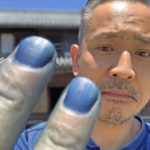
-
Fukutomi Sensei with Awa-ai hands (Tokushima 2020)
-

-
Hiroshige “Awa Naruto Whirlpool” 1853
-

-
Hokusai Waves, 1831
-
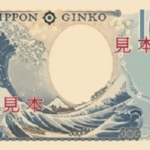
-
¥1000 bill to be released in 2024
-

-
Samurai (helmet) & retainers, Photo Felice Beato, 1870
-

-
Aizumicho Historical Museum, “Ai-no-Yakata”
-

-
Tokushima farmers separating indigo leaves from stalk
-
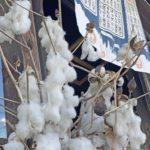
-
Cotton balls on display in a weaver’s workshop, Japan, 2019
-

-
Flea market, Japan, 2019
-

-
Boro Shorties inspection, MF® HQ, 2013
-
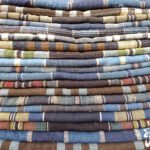
-
Antique Japanese woven textiles MF® HQ
-
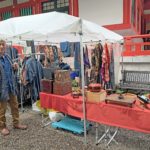
-
Antique Dealer, Japan, 2019
-

-
Indigo Noren, Japan, 2016
-

-
Indigo loot, Japan flea market, 2012
-
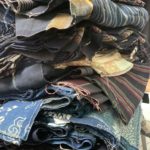
-
Indigo loot, Japan flea market, 2019
-

-
Vintage kasuri shopping, Japan, 2019
-

-
1900s-1920s Japanese Indigo Shimacho Swatch Book
-

-
Trying my hands at natural indigo with a local artisan, Japan, 2011
We were lucky enough to procure some yardage of this Awa-ai denim goodness, and cut a few CAMPUS BLOUSE and CALIFORNIAN Lot64 sets, right here in California, USA.
This is the second iteration of the MF® CAMPUS BLOUSE pattern, a woven fabric interpretation of our classic veg-tan leather Campus jacket. The corduroy collar on this edition (leftover yardage from the Continental Rive Gauche production) is a nod to the iconic 1950s blanket-lined Lee® Storm Rider, one of McQueen’s off screen go-to jackets in the 1960s-70s. Refer to this blog post for the saga behind morphing the Campus Jacket into the Campus Blouse.
We figured we’d match our fancy jacket with a pair of cool MF® CALIFORNIAN’s, in one of our most popular and classic Lot64 cut.
The Mister Freedom® CAMPUS BLOUSE and CALIFORNIAN Lot64 are designed and made in California, CA, in collaboration with Sugar Cane Co, both cut from premium SC Awa-ai fiber denim milled in Japan.
Mister Freedom® CAMPUS BLOUSE Awa-ai fiber denim edition.
SPECS:
PATTERN:
An original mfsc pattern inspired by 1930’s sportswear ‘Cossack’ type unlined leather jackets, with all construction/pattern edits necessary for a woven fabric MF® original adaptation.
FABRIC:
Shell: Sugar Cane Co “AWA-ai” fiber denim (blend of 70% cotton x 30% sugarcane fibers), 13 Oz., white/green line selvedge ID, dark indigo hue, dry, hairy and neppy, milled in Japan.
Collar: 14 Oz. wide wale corduroy, 100% cotton, cognac brown color, milled in Japan.
Trims: Black tea-core leather trims (pocket stops/side straps).
DETAILS:
* Woven fabric interpretation of our classic veg-tan leather Campus jacket.
* An original pattern inspired by 1930’s sportswear ‘Cossack’ type unlined leather jackets, with all necessary construction/pattern edits.
* Arm/cuff construction borrowed from our Ranch Blouse pattern.
* Trim 1930’s silhouette.
* One-piece back.
* Fully unlined, clean flat-felled seam construction.
* Slash pockets with leather arrowhead pocket stops.
* Side gussets featuring concealed Awa-ai denim selvedge ID.
* Adjustable side straps pattern inspired by our Drover Blouse.
* Keyhole button holes.
* Brown corozo wood ‘Cat Eyes’ buttons (aka ivory nut)
* Mister Freedom® original ‘The Sportsman’ black & gold rayon woven label.
* Made in California, USA, in an ethically-responsible and small family-owned factory.
SIZING:
The Campus Blouse Awa-ai denim comes UN-WASHED, and is cut so that the measurements match the labeling AFTER an initial cold soak/line dry.
We recommend the usual protocol before wearing:
•Cold soak for about 30-40mn, with occasional hand agitation.
•Machine spin dry cycle, and line dry.
•Wear briefly while still damp to set creases, then hang until fully dry.
My leather Campus jacket size is 38. I wear a 36 in this Awa-ai denim edition, after cold-soak/line dry, consistent with the sizing of my Campus Blouse Midnight Denim. I am about 5’7 ~142 lbs.
Please check actual post-soak measurements on our chart to dial in what works for your specific body specs/preferred silhouette.
Disclaimer: Using alternative methods for the initial shrink (such as soaking in hot water/full machine wash/heat dryer etc) may result in different sizing measurements. Do not boil this denim jacket, as it has leather trims.
Mister Freedom® CALIFORNIAN Lot64 Awa-ai fiber denim edition.
SPECS:
PATTERN:
Inspired by vintage 1950s-1960s era five-pocket blue jeans. Our LOT64 cut features a traditional fit, classic rise, with a slightly tapered leg for a 50s-60s vibe.
FABRIC:
Sugar Cane Co “AWA-ai” fiber denim (blend of 70% cotton x 30% sugarcane fibers), 13 Oz., white/green line selvedge ID, dark indigo hue, dry, hairy and neppy, milled in Japan.
Pocketing: Fancy NOS 100% cotton twill, woven stripe (navy blue pinstripe on white background.)
DETAILS:
* Classic vintage five-pocket blue jeans pattern and fit.
* Classic mid-rise.
* Button fly, original MF®-branded ‘silver’ tack buttons.
* Selvedge leg outseam.
* Fancy NOS stripe twill pocketing.
* MF® original white “M” stitch design on rear pockets.
* Natural cowhide leather MF®-branded patch on rear pocket. Will patinate with age.
* Twelve types of 100% cotton threads used for construction (gauge and color combination.) Main colors are yellow and orange.
* Coin pocket with concealed selvedge.
* Selvedge button hole fly placket.
* Hidden back pocket reinforcement rivets, with top pocket bar-tack stitching.
* Unmarked copper riveting for pocket reinforcement.
* Original MF® paper pocket flasher. Please note that some product photos above feature a black early proto flasher, not the red (“Sakura” edition) actually designed and used for the Awa-ai Californian production.
* Made in California, USA, in an ethically-responsible and small family-owned factory.
SIZING/FIT:
The Californian LOT64 AWA-Ai denim blue jeans come UN-WASHED and are cut so that actual measurements match the labeling AFTER an initial cold soak/line dry. We recommend the usual protocol before wearing:
- Cold soak for about 30-40mn, with occasional hand agitation.
- Machine spin dry and line dry.
- Wear briefly before fully-dry to shape and set creases, then hang until fully dry.
These Lot64 Awa-ai are considered true-to-size.
A tagged W32 will most-likely be the right size for an individual with an approximate measured waist of +/- 32 inches, and with average body proportions. Note that your natural waist is a bit bellow belly button level, not bellow the hips.
I (5’7 ~142 Lbs.) opted for a W30 in these, for a classic silhouette. I went un-hemmed and un-cuffed for a “sloppy” period stacking for a change.
The waist size that will work best for you depends on how you like your jeans to fit. Please refer to size chart.
CARE for your Awa-ai denim garments:
Wash when necessary, as with other premium denim garments.
We recommend turning the jeans and jacket inside-out to avoid potential marbling of the denim fabric. Wash separately from light-colored garments.
Machine wash with cold water, gentle cycle, eco-friendly mild detergent and line dry. Using hot water/heat dryer may result in excessive and irreversible shrinkage.
As with all indigo-dyed denim, temporary croaking (color bleeding) is to be expected, and the indigo color could potentially rub on light color garments and furniture. Indigo rubs can easily be spot-cleaned using a small amount of laundry detergent on a clean damp cloth.
Available from www.misterfreedom.com, our Los Angeles red brick HQ, and fine retailers around the World.
Email sales@misterfreedom.com or call 323-653-2014 with any questions unanswered above.
Thank you for your support,
Christophe Loiron
Mister Freedom®
©2023














Mister Freedom® CALIFORNIAN Lot64 “Frontier Duck”, 100% cotton canvas, Rust brown & Dark navy.
SS2023 & FW2023 mfsc Sportsman Catalog.
Made in USA.
We’ve issued the Mister Freedom® CALIFORNIAN in a plethora of premium fabrics through the years.
Since its 2010 introduction, our original classic five-pocket jeans pattern has been released in a wide range of NOS traditional indigo selvedge denims, eclectic premium Japanese fabrics such as double indigo twill, “Midnight” denim, Bedford cord Pique , corduroy, Jungle cloth, and cotton sateen.
For this iteration, we decided to give the CALIFORNIAN Lot64 an old school cotton canvas treatment, a nod to 1960s-70s brown duck 200Z Lee® Riders. For the denim collector, there was a fair amount of Lee® NOS floating around in the vintage world in the early 1990s, easily recognizable by the iconic yellow “boot and bucking bronco” Lee® paper flasher and desirable black/gold waistband label. I remember scoring a few stacks of those canvas specimen in old western wear stores at the time, and also sporting a pair.
For this project, we wanted domestic fabric and went out to source some nice and dry 12 Oz. cotton “Frontier” duck yardage, milled by Mt Vernon Mills in Georgia, USA.
We opted for two color options. A rusty brown similar to our Lee® brown duck jeans source of inspiration – also typical of classic Carhartt workwear – and a deep dark navy blue. For those considering a farmhand tuxedo, please note that the CALIFORNIAN rusty brown “Frontier” duck fabric is of a different dye lot from the “Frontier” Ranch Blouse NOS Duck.
This canvas duck fabric is woven on wide looms, resulting in unfinished edges, i.e. non selvedge. Therefore, as with the Californian Jungle cloth issue, the leg outseams of the pants are finished with overlock, another classic 1970s Lee® jeans trait.
We kept our MF® classic contrast orange/yellow combo stitching for the brown duck, and went tonal for the navy.
As often with our domestic production, we are using older NOS (New-Old-Stock, aka “Dead Stock”) fabric for the pocket bags. Not only as a “vintage aesthetics” choice, but in an effort to always use-up all yardage we have in stock.
Discarding left-over material is common practice in our overproducing fashion industry, an obvious waste of virgin raw material and resources, and pretty much an insult to our species’ intelligence at this point! We can do better.
Valuable and painstakingly-milled unused and uncut fabric yardage, let alone recently-manufactured clothes, should definitely not end up in landfills, nor in smoke.
The Mister Freedom® CALIFORNIAN Lot64 jeans, “Frontier Duck Canvas” edition, are designed and manufactured in California, USA, by Mister Freedom®, in collaboration with Sugar Cane Co.
SPECS:
PATTERN:
Inspired by vintage 1950s-1960s era five-pocket blue jeans. Our LOT64 cut features a traditional fit, classic rise, with a slightly tapered leg for a 50s-60s vibe.
FABRIC:
Dry 100% cotton “Frontier” duck canvas, 12 Oz., milled by Mt Vernon Mills, Georgia, USA.
Two color options, rusty brown and deep dark navy.
Pocket bags:
Brown canvas option: NOS 100% cotton navy blue twill with woven white pinstripe.
Navy canvas option: NOS 100% cotton fancy Dobby stripe weave, grayish/blue stripe on off-white background (left-over yardage from the production of the MF® Aristocrat Shirt.)
DETAILS:
* Classic vintage five-pocket blue jeans pattern, featuring a straight leg with a slight taper and a classic mid-to-high rise.
* Button fly, original MF®-branded metal cast tack buttons, “oxidized” silver color.
* Non-selvedge overlocked leg outseam.
* Fancy NOS fabric 100% cotton pocketing.
* MF® original “M” stitch design on rear pockets.
* Hand-debossed leather MF® branded patch on rear pocket, natural veg-tan cowhide for rusty brown canvas version, black tea-core veg-tan cowhide for navy canvas version.
* Contrast stitching on brown canvas version. Twelve types of 100% cotton threads used for construction (gauge and color combination.) Main colors are yellow and orange. Tonal stitching (black) on navy canvas version.
* Riveted coin pocket.
* Hidden back pocket reinforcement rivets, with top pocket bartack stitching.
* Unmarked copper riveting for pocket opening reinforcement.
* Original MF® paper pocket flasher (royal blue).
* Made in USA
SIZING/FIT:
The Californian LOT64 Frontier Duck Canvas jeans come UN-WASHED and are cut so that actual measurements match the labeling AFTER an initial cold soak/line dry. We recommend the usual protocol before wearing:
- Cold soak for about 30-40mn, with occasional hand agitation.
- Machine spin dry and line dry.
- Hang until fully dry.
The canvas Californians are considered true-to-size.
A tagged W32 will most-likely be the right size for an individual with an approximate measured waist of +/- 32 inches, and with average body proportions. Note that your natural waist is a bit bellow belly button level, not bellow the hips.
I opted for a W30 in these (5’7 ~142 Lbs.), for a fit silhouette, and went un-hemmed and un-cuffed for “sloppy” period stacking.
The size that will work best for you depends on your body type and how you like your jeans to fit.
Please refer to size chart, reflecting rinsed measurements.
CARE:
Launder when needed.
We recommend turning the jeans inside out to avoid marbling during laundering. Machine wash, cold water, gentle cycle, eco-friendly mild detergent and line dry.
Potential attractive patina may develop according to one’s activities, and frequency of wear/wash.
Available from www.misterfreedom.com, our Los Angeles brick & mortar store, and fine retailers around the World.
Email sales@misterfreedom.com or call 323-653-2014 with any questions unanswered above.
Thank you for your support.
Christophe Loiron
Mister Freedom®
©2023




 





















Mister Freedom® Terrence Sweater, 100% 2-Ply Cashmere.
mfsc FW2022 Hooper collection.
Made in Japan.
I am not a “collector” of anything tangible, but I have to confess a bit of an addiction to vintage cashmere sweaters.
Comes sweater season, knowing that racks will be filled with fresh stock of woolens, I can’t help raiding my local vintage stores to snag up what is actually old and fits me. Done that for years, so I do admit owning enough 50s-70s vintage specimen – in all colors and knit patterns, crew necks, V-necks, turtlenecks – to last me several lifetimes at this point!
I actually do wear them all, and often, so I don’t feel that much of a dodo just hoarding them as moth food. Being allergic to wool, cashmere keeps me cosy in the winter, cool for most of the rest of the year in Southern California, and is a perfect light-weight traveling companion. Also, a good cashmere sweater never goes out of style, and always feels like a cuddle!
For anyone in the market for affordable cashmere, I recommend sourcing from used clothing stores and flea markets.
Fast-fashion labor-cost-cutting specialists and massive landfill contributors Shein, H&M and the likes may offer cashmere sweaters for less than a $100 (with zero transparency and usually disposable), but one can definitely score perfect pre-owned luxury specimens (with zero carbon footprint the second time around) from vintage stores for a mere third of that.
When considering buying a brand new cashmere garment, one needs to do so responsibly. Tantalizing low retail prices flashed by fast-fashion outlets have recently ramped-up demand of raw material, with, as always, an impact on the whole manufacturing chain. Heard about masstige? (must read 2014 article from the Guardian on the subject!)
According to the BBC via this article, nomadic herders of cashmere goats make for about 40% of Mongolia’s scarce population, a country that supplied 20% of the global demand for raw cashmere fibers in 2020.
To paraphrase, cashmere goats are known for overgrazing, causing desertification, and loss of grassland means lower cashmere fiber output per goat. Wholesale goat hair prices fall due to fast fashion’s new dictate on market prices. Shortchanged herdsmen take up slack by buying more goats… and there you have it: an unsustainable environmental goat rodeo.
Takeaway from all that? 100% cashmere is and should stay a luxury fabric, and cannot (shouldn’t?) be cheap. Not in an elitist sense, but for the fact that if one is not paying the price at retail level, someone certainly is along the production process.
A quality cashmere sweater should be considered as an investment. If well cared-for and properly stored, cashmere is known to last a lifetime. Besides considering brand transparency, provenance (not just “imported”), proper garment pedigree, cost-per-wear should also play in making a wise decision.
With this caveat emptor in place, now on with this new Mister Freedom® TERRENCE fella!
Considering the fact that the fine insulating undercoat fibers of the Capra Circus Laniger average 19 microns in diameter – human hair is about 100 microns – it is fair to claim that the cashmere goat hair used in the knitting of our Mister Freedom® TERRENCE sweater is finer than frog hair.
This article, amongst many others on the interwebs, dives into what defines cashmere in the garment industry, along with other considerations.
As mentioned, I’m a seasoned vintage cashmere sweater hunter, but the pickier I get about only selecting the right one (proper period fit, cut, proportions, knit, ply, quality, condition etc), the trickier the sourcing gets. Kind of a wild goose chase. I know there are great traditional cashmere knitwear brands out there, producing fine sweaters, but I never had an urge to invest in a brand new one, as the cut/fit always feels too contemporary for me.
So, for similar reasons as to why our basic Mister Freedom® undershirts exist today (the USA-made Skivvies and Stanleys Ts were conceived as an alternative to having to endless scour thrift stores for used and wearable tubular knit undershirts that fit like old school Hanes or Fruit of the Loom), we decided to come up with our own old-school cashmere sweater!
With the help of our Sugar Cane Co partners, we sourced our cashmere yarns from “FUKAKI Woollen Textile Co“, one of the most reputable source in Japan, a mill founded in 1887, specialized in spinning and knitting cashmere since 1931, a member of the CCMI, Cashmere and Camel Hair Manufacturers Institute, and ISO 14001 certified.
Side note, we could have slashed costs considerably by going the China route for this project (watched Death By China?), but stuck to our MF® guns and commitment to solely manufacture in Japan and USA.
With a full vertically-integrated operation in Japan, Fukaki imports some of the finest raw white cashmere fibers from Inner Mongolia – white fibers being the most expensive compared to grey or brown, as they can be dyed – sourced from ethical producers/jobbers.
A team of Japanese textile experts then sorts, selects, grades, dyes, and spins the yarns, using unique manufacturing methods, knitting some of the most reputable cashmere sweaters in today’s fashion industry.
After a loooong journey of trying to ramp up our knowledge on technical cashmere manufacturing, actual production R&D, crucial decision-making on design and fabric in the midst of supply chain challenges and a pandemic, multiple sample making, constructive criticism, … , we eventually had the MF® TERRENCE figured out!
We opted for 2-ply cashmere (meaning two twisted yarns make one strand), settled on NM 2/26 (where NM is Metric Number, 2 being the ply, and 26 the length divided by the weight of the cashmere yarn, defining its fineness, the higher the number the finer, 26 being a classic magic number for warmth, minimal piling, and longevity of the garment, to the best of my knowledge), and high gauge knit (how tightly-knit and dense the fabric is, measured by the number of vertical rows per square inch, I believe 12 in our case.)
The resulting cashmere fabric of our TERRENCE feels chunky yet breathable, tightly knit with pretty good mechanical stretch recovery, and soft to the touch as Joe’s show hair! (“show hair” is a term coined by our dear friend Jillian)
For the type of knit, we wanted something more textured and “special” than plain knit, so we went with cable knit, specifically a classic “Twisted Twin Cable” pattern, with “Chunky Rib Stitch” cuffs and waistband pattern combo. All that inspired by a 1960s vintage specimen from my stash, sporting a “BRAININ of Bond St… Made in Scotland” label.
We chose V-neck for the collar pattern, with a classic depth that worked for our esthetics, not too deep, not too shallow, chef kiss.
The major MF® twist is in the cut and fit of our sweater. We wanted a “vintage” silhouette that would set apart the TERRENCE from his contemporaries: slightly shorter body complimenting one’s natural waist and classic rise trousers, long foldable 40s-50s style sleeve cuffs, and old school 4 inch-wide waistband.
Longer torsos and thin waistbands being the norm for modern contemporary sweaters, our baby is quite unique in its style class, and has definitely quelled my personal quest for hunting down the perfect vintage specimen!
Color wise, it was hard to settle on the right palette, but we eventually opted for classic black, “Yale” blue, and “Ice Blu” (a nod to our Ice Blu denim.)
A beautiful gold color was also part of our first choice, but was unfortunately unavailable at the time of production.
Lastly, the “Terrence” moniker is a reference to a famous Hollywood actor who sure liked his V-neck sweaters, on and off screen. His simple and timeless style is often an inspiration for us, as relevant then as now.
The MF® TERRENCE Sweater, 100% 2-Ply Cashmere, is designed in California by Mister Freedom® and manufactured in Japan from a well-established reliable source, in collaboration with Sugar Cane Co.
SPECS:
PATTERN:
Inspired by classic and timeless vintage V-Neck wool sweaters, 50s-60s casual styles with period fits and silhouettes.
FABRIC:
Luxurious 100% 2-ply Mongolian Cashmere, fine NM 2/26 yarn, sustainable sourcing.
Available in three classic colors: black, “Yale” blue, and “Ice Blu”.
DETAILS:
* Original pattern inspired by vintage classic cashmere sweaters and timeless period fashion.
* Old school 50s-60s silhouette.
* Luxurious 100% 2-ply Mongolian Cashmere, fine NM 2/26 yarn, sustainably sourced.
* Raw white wool material processed/dyed/knit in Japan.
* High 12 gauge knit.
* Classic depth V-neck style with ribbed stitch collar roll.
* “Chunky Rib Stitch” long foldable cuffs & wide waistband.
* Classic “Twisted Twin Cable” knit pattern.
* Panel knitting construction.
* Original mfsc woven rayon label.
* Crafted in Japan by a reputable source member of the CCMI.
* Produced in limited quantities.
SIZING/FIT:
The MF® TERRENCE cashmere sweater comes ready-to-wear, it does not need any pre-soaking shrinking routine before wear.
At 5’7 ~145 Lbs, I opted for a MEDIUM, for an old school silhouette.
Please remember that the specific proportions and “vintage fit” of this original garment are part of its design and DNA. Our TERRENCE features a slightly shorter body (pairing well with classic high to mid-rise pants), wide ribbed cuffs and wide ribbed waistband (typical period details of 1940s-50s vintage specimen), setting it apart from the modern design twist of the vast majority of contemporary mens sweaters.
CARE:
Hand wash only, every 5 to 10 wears, according to one’s activities, and layering choices.
When laundering is needed :
* Soak in cold water for ~30mn, using biodegradable woolen mild detergent. Some use baby shampoo, Dirty Labs (USA), Eucalan (Canada), The Laundress (USA) etc…
* Hand agitate to loosen dirt, gently moving the sweater around.
* Gently squeeze sweater, fill sink with fresh cold water, rinse.
* Gently squeeze sweater again (do not wring!), lay sweater on clean white towel, flat surface (do not hang!)
* Let air dry, gently fluffing and flipping garment occasionally if necessary.
We do not recommend dry-cleaning as the harsh process tends to break the fine and fragile cashmere natural fibers.
At the end of your sweater season, properly launder your TERRENCE before storing it in a moth-proof environment (sealed bag/plastic bin) with natural herbal scents (cedar blocks/lavender bags etc.)
Available from www.misterfreedom.com, our Los Angeles brick & mortar store, and fine retailers around the World.
Email sales@misterfreedom.com or call 323-653-2014 with any questions unanswered above.
Thank you for your support.
Christophe Loiron
Mister Freedom®
©2023
|










































